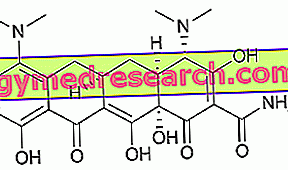Minocycline is a broad-spectrum antibiotic belonging to the tetracycline class. It is available as hard capsules for oral use and as a periodontal powder.

Minocycline - Chemical Structure
Indications
For what it uses
Minocycline is used in the treatment of infections caused by Gram-positive and Gram-negative bacteria sensitive to it.
More specifically, minocycline is used to treat:
- Respiratory tract infections;
- Genito-urinary tract infections;
- Skin and soft tissue infections;
- Otorhinolaryngological infections;
- Eye infections.
Periodontal powder containing minocycline is used to stop bacterial growth in the oral cavity in cases of chronic inflammation of the teeth following dental treatments.
Warnings
The onset of any type of allergic reaction during minocycline therapy requires immediate treatment interruption.
Minocycline - like all tetracyclines - can be deposited in the teeth and bones during the period of formation and growth, can cause hypoplasia and can alter tooth coloring (teeth can take on a yellow-brown color). Therefore, the drug should not be administered during pregnancy, lactation and in children under 12 years of age.
The use of minocycline can promote the development of infections caused by bacteria resistant to the same antibiotic or fungi.
Minocycline can cause photosensitivity reactions. If these reactions appear, treatment with the antibiotic must be stopped.
Minocycline can cause pigmentation of the skin, nails and other tissues.
Since minocycline can cause hepatotoxicity, the drug should be used with caution in patients with pre-existing liver problems.
Minocycline may aggravate muscle weakness in patients with myasthenia gravis and may worsen systemic lupus erythematosus in patients who are affected.
When minocycline is used for long periods, it is necessary to carry out regular checks on blood counts and kidney and liver function.
Interactions
Simultaneous use of minocycline and the following drugs may decrease the absorption of minocycline:
- Antacid drugs based on magnesium, aluminum or calcium salts;
- Iron-based preparations ;
- Milk and dairy products .
Minocycline may affect the activity of other antibiotics, such as aminoglycosides and beta-lactams .
Minocycline may increase the effects of oral anticoagulants, therefore, the dose of these may need to be adjusted in patients who need to start antibiotic therapy.
In any case, you need to inform your doctor if you are taking - or if you have recently been - drugs of any kind, including over-the-counter drugs and herbal and / or homeopathic products.
Side effects
Minocycline can cause various types of side effects, although not all patients experience them. The type of adverse effects and the intensity with which they occur depend on the sensitivity that each individual has towards the drug.
The following are the main adverse effects that can occur during treatment with minocycline.
Gastrointestinal disorders
Minocycline therapy can cause:
- Nausea or vomiting;
- Dyspepsia;
- Diarrhea;
- Esophagitis;
- Enterocolitis;
- Pancreatitis;
- Stomatitis;
- Glossitis;
- Pseudomembranous colitis.
Hepatobiliary disorders
Treatment with minocycline may result in increased levels of liver enzymes in the bloodstream, cholestasis, hepatitis and jaundice.
Nervous system disorders
Minocycline therapy can cause dizziness, vertigo and headache.
Skin and subcutaneous tissue disorders
Treatment with minocycline may cause:
- Erythematous and maculopapular rash;
- Hyperpigmentation of the skin and nails;
- Photosensitivity reactions;
- Alopecia;
- Exfoliative dermatitis;
- Stevens-Johnson syndrome.
Allergic reactions
Minocycline can trigger allergic reactions in sensitive individuals who may manifest themselves as angioedema, urticaria or anaphylaxis.
Blood and lymphatic system disorders
Minocycline therapy may promote the onset of:
- Neutropenia, ie decrease in the number of neutrophils in the bloodstream;
- Leukopenia, ie decrease in the number of leukocytes in the bloodstream;
- Plateletopenia, ie decrease in the number of platelets in the blood;
- Hemolytic anemia;
- Aplastic anemia.
Lung and respiratory tract disorders
Treatment with minocycline can cause dyspnoea, bronchospasm and pneumonia.
Kidney and urinary tract disorders
Minocycline therapy can cause nephritis and kidney failure.
Cardiovascular disorders
Treatment with minocycline can cause myocarditis, pericarditis and vasculitis.
Other side effects
Other side effects that may occur during minocycline therapy are:
- Intracranial hypertension;
- Tooth discoloration;
- Tinnitus;
- Hearing loss;
- Visual disturbances;
- Myalgia;
- arthralgia;
- Systemic lupus erythematosus;
- Oral and anogenital candidiasis;
- Vulvovaginitis.
Side effects associated with the application of periodontal dust
Following the application of periodontal dust, they can occur:
- Inflammation of the tissue around the treated tooth;
- Transient pain in the oral cavity;
- Toothache;
- Inflammation of the gum;
- Inflammation of the oral mucosa;
- Mouth ulcers;
- Inflammation of the throat;
- Swelling of the gums (may be a hypersensitivity reaction).
Overdose
Following ingestion or overdose of minocycline, you must contact your doctor immediately and go to the nearest hospital.
Action mechanism
Minocycline is a tetracycline and - as such - it exerts its bacteriostatic action (ie able to inhibit bacterial growth) by interfering with the protein synthesis of bacteria.
Protein synthesis in bacterial cells takes place thanks to organelles called ribosomes. These organelles consist of ribosomal RNA and proteins associated with each other to form two subunits: the 30S subunit and the 50S subunit.
The task of the ribosome is to bind and translate the messenger RNA coming from the cell nucleus and to synthesize the proteins for which it encodes.
Minocycline binds to the 30S ribosomal subunit, preventing the binding of messenger RNA to the same ribosome. By doing so, protein synthesis is blocked.
Mode of Use - Posology
Minocycline is available for oral administration as hard capsules. Furthermore, it is available as a periodontal powder.
Following are some indications on the doses of minocycline usually used in therapy.
Oral administration (hard capsules)
In adults, the dose of minocycline usually given is 50-200 mg every twelve hours. The exact dose of drug administered is established by the doctor depending on the type of infection to be treated.
To avoid possible esophageal irritation, it is advisable to take the capsule with plenty of water an hour before bedtime.
In patients with renal or hepatic impairment, the dose of minocycline administered may need to be adjusted.
Periodontal powder
Minocycline based periodontal powder should only be administered by healthcare professionals with experience in dentistry.
After applying the powder, the following guidelines should be followed:
- Do not brush your teeth for the next twelve hours of treatment;
- Do not eat crunchy, hard or hard to chew foods and avoid touching the treated area for a week after treatment;
- Do not use dental floss around the treated tooth for at least ten days after treatment.
Pregnancy and breastfeeding
Minocycline is able to cross the placenta and delay embryo-fetal skeletal development. Therefore, the use of the drug by pregnant women should be avoided.
Minocycline is excreted in breast milk and can cause harm to the infant. Therefore, breastfeeding mothers should not take the antibiotic.
Contraindications
The use of minocycline is contraindicated in the following cases:
- In patients with known hypersensitivity to minocycline;
- In patients with known hypersensitivity to other tetracyclines;
- In patients under 12 years of age;
- In patients with hepatic and / or renal insufficiency;
- Pregnant;
- During breastfeeding.



